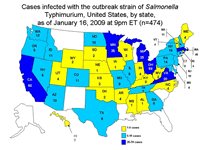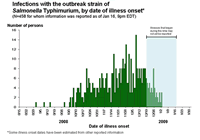Multistate Outbreak of Salmonella Typhimurium Infections Linked to Peanut Butter, 2008–2009
Posted January 17, 2009
Click here to go to the Final Update
This outbreak appears to be over. However, Salmonella is an important cause of human illness in the United States. More information about Salmonella, and steps people can take to reduce their risk of infection, can be found on the CDC Salmonella Web Page.
On this Page
Persons Infected with the Outbreak Strain of Salmonella Typhimurium, United States, by State
Epidemic Curve
CDC is collaborating with public health officials in many states and the United States Food and Drug Administration (FDA) to investigate a multistate outbreak of human infections due to Salmonella serotype Typhimurium.
As of 9PM EDT, Friday, January 16, 2009, 474 persons infected with the outbreak strain of Salmonella Typhimurium have been reported from 43 states. The number of ill persons identified in each state is as follows: Alabama (1), Arizona (10), Arkansas (4), California (60), Colorado (11), Connecticut (8), Georgia (6), Hawaii (3), Idaho (11), Illinois (5), Indiana (4), Iowa (1), Kansas (2), Kentucky (3), Maine (4), Maryland (8), Massachusetts (40), Michigan (25), Minnesota (35), Missouri (9), Mississippi (1), Nebraska (1), New Hampshire (11), New Jersey (19), New York (19), Nevada (5), North Carolina (4), North Dakota (10), Ohio (64), Oklahoma (2), Oregon (5), Pennsylvania (14), Rhode Island (4), South Dakota (2), Tennessee (9), Texas (6), Utah (4), Vermont (4), Virginia (20), Washington (13), West Virginia (2), Wisconsin (3), and Wyoming (2).
Among the 458 persons with dates available, illnesses began between September 8, 2008 and January 2, 2009. Patients range in age from < 1 to 98 years; 47% are female. Among persons with available information, 23% reported being hospitalized. Infection may have contributed to six deaths.
The outbreak can be visually described with a chart showing the number of persons who became ill each day. This chart is called an epidemic curve or epi curve. The epi curve and information about interpreting it may be found here. It shows that illnesses began between September 8, 2008 and January 2, 2009, with most illnesses beginning after October 1, 2008. Illnesses that occurred after December 18, 2008 may not yet be reported due to the time it takes between when a person becomes ill and when the illness is reported. This takes an average of 2 to 3 weeks. Please see the Salmonella Outbreak Investigations: Timeline for Reporting Casesfor more details.
Outbreak Investigation
The investigation is ongoing, and exposures to peanut butter and other peanut butter-containing products are being examined. Preliminary analysis of an epidemiologic study conducted by CDC and public health officials in multiple states comparing foods eaten by ill and well persons has suggested peanut butter as a likely source of the bacteria causing the infections. To date, no association has been found with major national brand name jars of peanut butter sold in grocery stores.
An epidemiologic investigation by the Minnesota Department of Health suggested King Nut brand creamy peanut butter as a likely source of Salmonella infections among many ill persons in Minnesota. The Minnesota Department of Agriculture Laboratory isolated the outbreak strain of Salmonella Typhimurium from an open 5-pound container of King Nut brand creamy peanut butter. This product is distributed in many states to establishments such as long-term care facilities, hospitals, schools, universities, restaurants, delis, cafeterias, and bakeries. It is not sold directly to consumers and is not known to be distributed for retail sale in grocery stores.
The Connecticut Department of Public Health Laboratory and the Georgia Department of Agriculture independently isolated Salmonella from unopened 5-pound containers of King Nut brand peanut butter. Further tests are pending to determine if this Salmonella is the outbreak strain.
Clusters of infections in several states have been reported in schools and other institutions, such as long-term care facilities and hospitals. King Nut is the only brand of peanut butter used in those facilities for which we have information.
King Nut is produced by Peanut Corporation of America in Blakely, Georgia. This facility is now recalling two products it makes: (1) peanut butter (made on or after August 8, 2008) and (2) peanut paste (made on or after September 26, 2008) at the Georgia facility. In many instances, the peanut butter and peanut paste is further distributed to manufacturers to be used as ingredients in many products, including cookies, crackers, cereal, candy, ice cream and other foods.
The list of products that may be affected is still being determined and is incomplete at this time. However, a list of products known to be implicated at this point in the investigation can be found on the FDA website. FDA and the product manufacturers are working to determine the list of affected products, which may be extensive. Some companies have already announced whether their products include ingredients being recalled by Peanut Corporation of America, Georgia, and more companies are expected to make similar announcements.
CDC with state partners is continuing to identify and interview ill persons. To clarify the types of peanut-butter containing foods that are associated with the outbreak, CDC is currently conducting a second national case-control study. State partners are also collecting and testing various peanut-butter containing foods.
Recommendations
Based on available information, CDC and FDA recommendations include:
For consumers
- Do not eat products that have been recalled and throw them away in a manner that prevents others from eating them.
- Postpone eating other peanut butter containing products (such as cookies, crackers, cereal, candy and ice cream) until more information becomes available about which brands may be affected.
- Persons who think they may have become ill from eating peanut butter are advised to consult their health care providers.
For retailers
- Stop selling recalled products.
For directors of institutions and food service establishments
- Ensure that they are not serving recalled products.
For manufacturers
- Inform consumers about whether their products could contain peanut butter or other peanut-containing products from Peanut Corporation of America. If a manufacturer knows their products do not contain peanut-containing products from PCA, they should inform consumers of that.
To date, no association has been found with major national brand name jars of peanut butter sold in grocery stores.
For more information
- For the latest information about the epidemiological investigation, go to the CDC Salmonella Typhimurium Outbreak Investigation Update website.
- For the latest information about recalled products, go to FDA Salmonella Typhimurium Outbreak site.
- More general information about Salmonella can be found on the CDC Salmonella website.
Public health officials will advise the public if more products are identified as being associated with the outbreak.
Clinical Features/Signs and Symptoms
Most persons infected with Salmonella develop diarrhea, fever, and abdominal cramps 12–72 hours after infection. Infection is usually diagnosed by culture of a stool sample. The illness usually lasts 4 to 7 days. Although most people recover without treatment, severe infections may occur. Infants, elderly persons, and those with impaired immune systems are more likely than others to develop severe illness. When severe infection occurs, Salmonella may spread from the intestines to the bloodstream and then to other body sites and can cause death unless the person is treated promptly with antibiotics.
More information on this investigation can be found below.
- Connecticut Department of Consumer Protection press release
- Georgia Department of Agriculture
- Minnesota Department of Health and Minnesota Department of Agriculture press release
- FDA – Salmonella Typhimurium Outbreak
- More information on Salmonella
- More general information about Salmonella can be found here under Salmonella FAQs.
The next web posting is expected on Monday, January 19, 2009.
Get email updates
To receive email updates about this page, enter your email address:
Contact Us:
- Centers for Disease Control and Prevention
1600 Clifton Rd
Atlanta, GA 30333 - 800-CDC-INFO
(800-232-4636)
TTY: (888) 232-6348 - Contact CDC–INFO
 ShareCompartir
ShareCompartir




